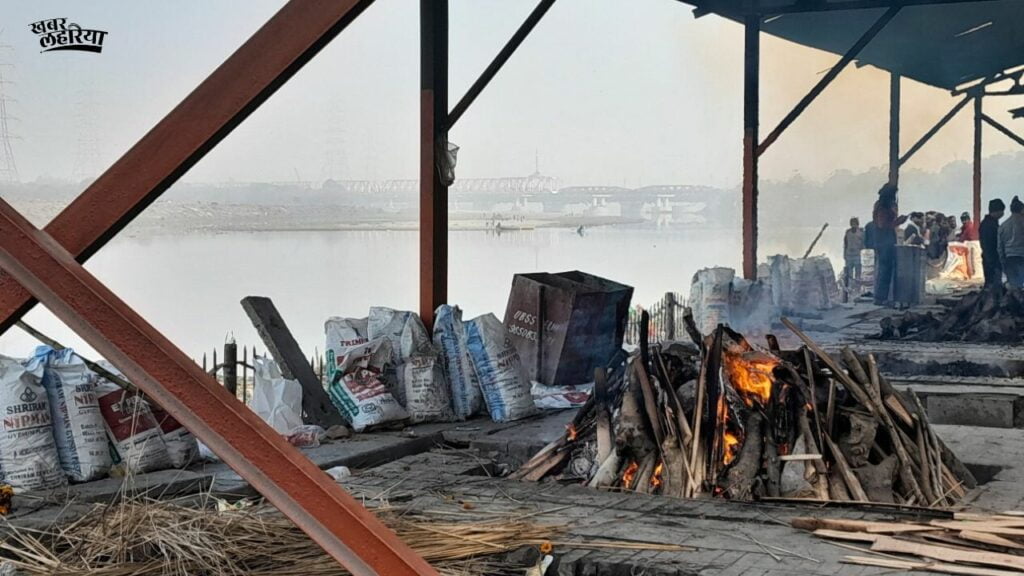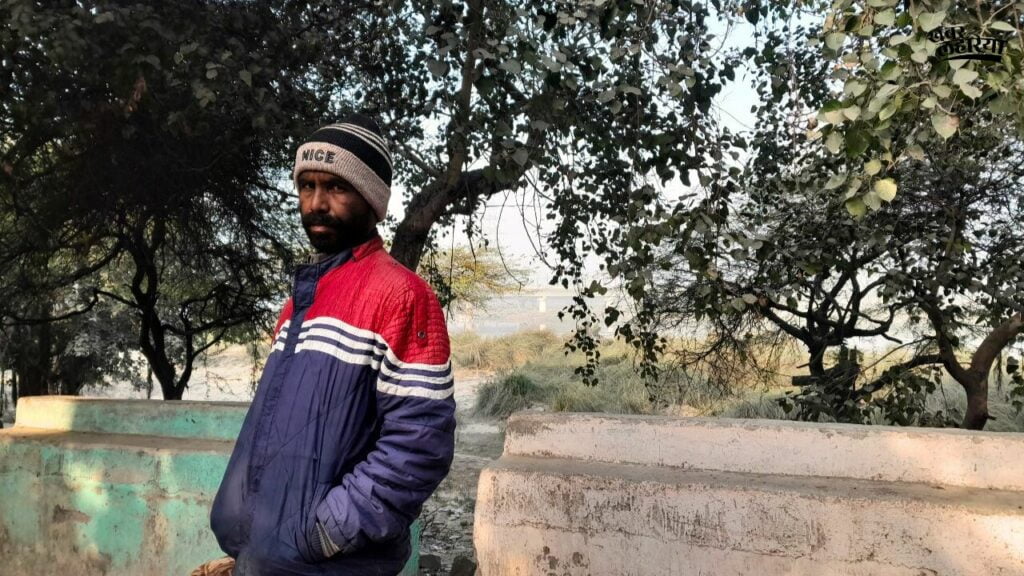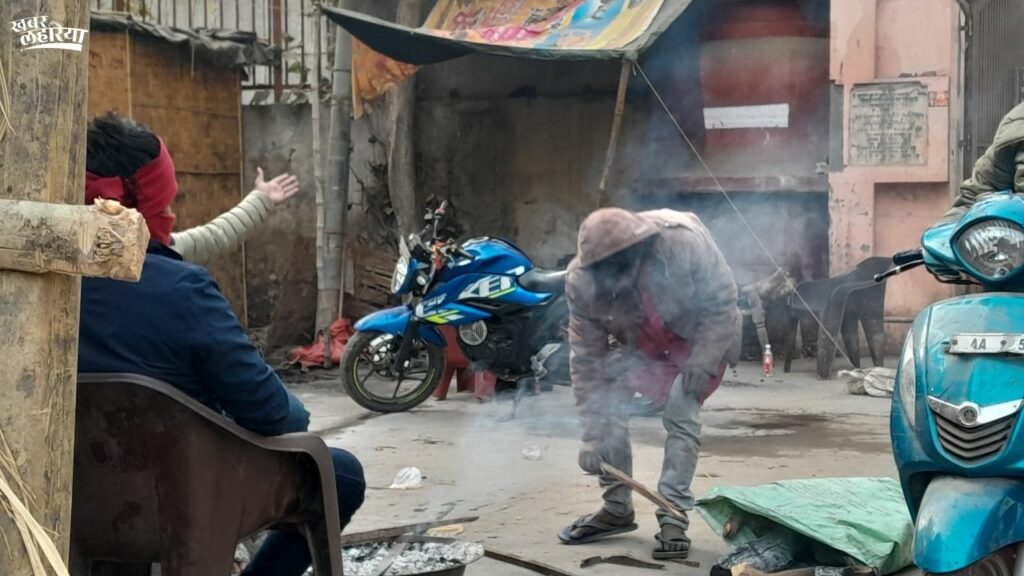Nigam Bodh Ghat in Delhi witnesses a unique coexistence of cremation and the struggles of 500 homeless residents relying on cremation logs for warmth. The demolition of night shelters adds to their challenges, highlighting a crucial gap in the city’s response to homelessness.
Nigam Bodh Ghat, a well-known crematorium in Delhi, presents a unique scene where life and death coexist. On one side, a cremation ceremony is underway, while on the other, homeless persons, who reside behind the ghat, collect the leftover cremation logs. In the chilly Delhi weather, these logs serve as an indispensable source of warmth and fuel for cooking for the people living in the vicinity.
Sooraj, a 31 year-old, works as a waste-picker in the Kashmere Gate area of Central Delhi. He lives with his brother and niece in the Yamuna Pushta area. Earlier, he undertook various jobs such as portering and construction but an accident rendered him unable to lift heavy weights. “Now waste picking is the only option available to me,” he said. Sooraj, originally from Mehram Nagar, was orphaned early in life. For a while he lived with his grandparents then landed into an orphanage, soon he had to leave that and since then he had been living either on the streets or in rain baseras. His rain basera was one of the eight night shelters demolished by Delhi Urban Shelter Improvement Board, last year in march, ostensibly under the pretext of G-20.
For more than 14 years, Sooraj has relied on collecting logs to fend off the cold. “There’s no respite from the cold; the demolition has taken away whatever meagre comfort we had,” he said. The area where Sooraj resides sees an influx of people during seasonal migration, exacerbating the challenges faced by the inhabitants due to limited space to accommodate those seeking shelter and livelihood opportunities.
Sunil Kumar Aledia from Centre for Holistic Development argues that, “Homeless persons in Delhi, many of whom are migrants, actively contribute to the building and development of the city.” However, he goes on to add that, “They often face derogatory treatment as outsiders and are unfairly labelled as space encroachers.”
According to official 2011 census data, the count of homeless individuals in Delhi stands at just over 46,000. However, activists assert that the present scenario paints a starkly different picture, with estimates ranging between 1.5 to 2 lakh homeless individuals in the city, including around 30,000 women. These staggering figures far exceed the capacity of available beds in night shelters, highlighting a significant gap between the official statistics and the reality on the ground.
Moreover, the government’s approach to providing temporary lodging for the homeless through rain baseras has been criticized for its limited perspective. The strategy tends to view shelters solely as places for sleeping, overlooking the broader needs of the residents. Night shelters, often constructed in porta cabins or parking structures, lack the essential spaces required for a dignified life. These spaces include areas for socialising, cooking (kitchens), childcare, and storage for personal belongings. The current strategy falls short in addressing the holistic needs of the homeless population, hindering their ability to lead a life with dignity.
The dependency on the cremation logs might scorn some faces but many others like Sooraj find their refuge. According to IMD data spanning from 1992 to 2023, the highest count of cold wave days in January occurred in 2008, totaling 12 days. Last year saw two cold wave periods in January, occurring from January 5 to 9 and January 16 to 18. Notably, the initial stretch of five days marked the longest cold wave experienced in the past decade.
“This year I bought a jacked and it cost me Rs.700 ”, shares Chandan, a 45-year-old who works in the crematorium, collecting ashes. He earns Rs. 50 for each pyre, and typically, two to four people work together on any given day. Depending on the generosity of those they assist, some may give an additional Rs. 50 or 100 for tea and snacks. Their entire livelihood depends on these earnings, which means that a jacket ends up costing Chandan almost double his daily income.
The Delhi government unveiled its winter action plan in December last year, aimed at providing food and shelter for the homeless in the city. To implement this plan, sixteen teams have been mobilised to actively engage in relocating individuals living on the streets. In addition, a centralised control room operating 24×7 has been set up to oversee and coordinate the efforts. To enhance the plan’s effectiveness, three helpline numbers have been made operational, facilitating swift responses to the needs of the homeless during the winter season.
Commenting on the effectiveness of the winter action plan, Sunil remarked, “The government has made tall claims, the reality falls significantly short in terms of availability and capacity. If the government says there is space for 16,000 people to sleep, the actual capacity is closer to 6,000 people… So, there is indeed a shortage of space.””
Meanwhile, Sooraj and Chandan set out for Nigam-Bodh as early morning and evening are the busiest hours to collect logs from the crematorium. Their hope is that the government could facilitate tents and, at the very least, refrain from demolishing their temporary shelters.
-Written by Sejal
‘यदि आप हमको सपोर्ट करना चाहते है तो हमारी ग्रामीण नारीवादी स्वतंत्र पत्रकारिता का समर्थन करें और हमारे प्रोडक्ट KL हटके का सब्सक्रिप्शन लें’






